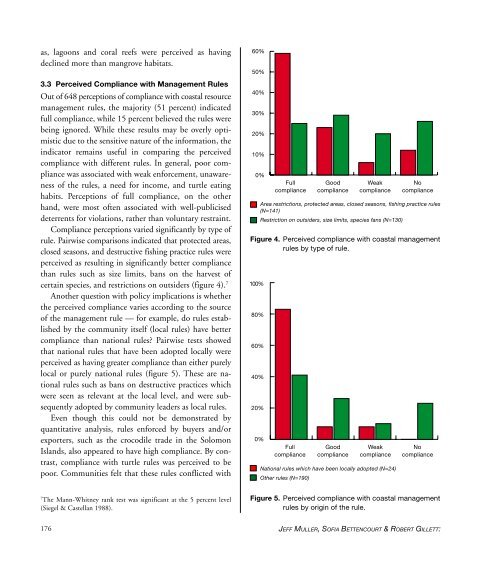Create successful ePaper yourself
Turn your PDF publications into a flip-book with our unique Google optimized e-Paper software.
as, lagoons and coral reefs were perceived as having<br />
declined more than mangrove habitats.<br />
3.3 Perceived Compliance with Management Rules<br />
Out <strong>of</strong> 648 perceptions <strong>of</strong> compliance with coastal resource<br />
management rules, the majority (51 percent) indicated<br />
full compliance, while 15 percent believed the rules were<br />
being ignored. While these results may be overly optimistic<br />
due to the sensitive nature <strong>of</strong> the information, the<br />
indicator remains useful in comparing the perceived<br />
compliance with different rules. In general, poor compliance<br />
was associated with weak enforcement, unawareness<br />
<strong>of</strong> the rules, a need for income, and turtle eating<br />
habits. Perceptions <strong>of</strong> full compliance, on the other<br />
hand, were most <strong>of</strong>ten associated with well-publicised<br />
deterrents for violations, rather than voluntary restraint.<br />
Compliance perceptions varied significantly by type <strong>of</strong><br />
rule. Pairwise comparisons indicated that protected areas,<br />
closed seasons, and destructive fishing practice rules were<br />
perceived as resulting in significantly better compliance<br />
than rules such as size limits, bans on the harvest <strong>of</strong><br />
certain species, and restrictions on outsiders (figure 4). 7<br />
Another question with policy implications is whether<br />
the perceived compliance varies according to the source<br />
<strong>of</strong> the management rule — for example, do rules established<br />
by the community itself (local rules) have better<br />
compliance than national rules Pairwise tests showed<br />
that national rules that have been adopted locally were<br />
perceived as having greater compliance than either purely<br />
local or purely national rules (figure 5). These are national<br />
rules such as bans on destructive practices which<br />
were seen as relevant at the local level, and were subsequently<br />
adopted by community leaders as local rules.<br />
Even though this could not be demonstrated by<br />
quantitative analysis, rules enforced by buyers and/or<br />
exporters, such as the crocodile trade in the Solomon<br />
Islands, also appeared to have high compliance. By contrast,<br />
compliance with turtle rules was perceived to be<br />
poor. Communities felt that these rules conflicted with<br />
60%<br />
50%<br />
40%<br />
30%<br />
20%<br />
10%<br />
0%<br />
Full<br />
compliance<br />
Good<br />
compliance<br />
Weak<br />
compliance<br />
No<br />
compliance<br />
Area restrictions, protected areas, closed seasons, fishing practice rules<br />
(N=141)<br />
Restriction on outsiders, size limits, species fans (N=130)<br />
Figure 4. Perceived compliance with coastal management<br />
rules by type <strong>of</strong> rule.<br />
100%<br />
80%<br />
60%<br />
40%<br />
20%<br />
0%<br />
Full<br />
compliance<br />
Good<br />
compliance<br />
Weak<br />
compliance<br />
National rules which have been locally adopted (N=24)<br />
Other rules (N=190)<br />
No<br />
compliance<br />
7<br />
The Mann-Whitney rank test was significant at the 5 percent level<br />
(Siegel & Castellan 1988).<br />
Figure 5. Perceived compliance with coastal management<br />
rules by origin <strong>of</strong> the rule.<br />
176<br />
JEFF MULLER, SOFIA BETTENCOURT & ROBERT GILLETT:


















